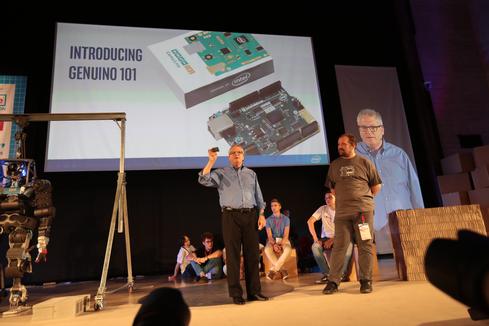Intel Primes The Internet Of Things PumpIntel Primes The Internet Of Things Pump
Intel has enhanced its Internet of Things platform, including new forms of silicon for "smart" things, partnering with other companies to put it to use.


Intel's Arduino 101: 11 Reasons You Need It
Intel's Arduino 101: 11 Reasons You Need It (Click image for larger view and slideshow.)
Intel wants to enable the Internet of Things with billions of Intel processors humming on it, and it is laying more groundwork for developers, partners, and commercial companies to seize the initiative to create it.
Intel hosted an IoT Insights event Tuesday, Nov. 3, at The NWBLK (pronounced "new black"), a retail and events venue in San Francisco's Mission district. It highlighted what Intel and partners now bring to the Internet of Things.
"I really believe this is going to change the way we live, think, and work," said CEO Brian Krzanich.
Intel has done an IoT pilot project with Levi Strauss & Co. In the pilot, sensors with bar code readers were placed on clothes displays to feed data (e.g., what's in stock, what's been removed, what's been moved) to a cloud repository. Every few minutes, "an analytical application looks at the incoming data on a whole-store basis" and provides a report. If someone has moved jeans into the wrong place, staff is alerted.
Levi Strauss learned that "for every three percent gain in inventory accuracy, you get a one percent improvement in sales," Krzanich said.
[Want to see how Intel launched its IoT platform? See Intel Launches Internet Of Things Platform.]
Last December, Intel launched its Internet of Things Platform to help early implementers collect data from devices, move it onto the network, and store it for analysis. On Tuesday, the company announced enhancements to the platform, including new forms of silicon for "smart" things.
The Intel Quark System on a Chip was introduced in 2013 as smaller, slower, and lower-power processor than the Intel Atom family, designed for mobile devices. Intel introduced a microcomputer based on Quark, named Edison, in January 2014, capable of both Bluetooth and WiFi connections.
Intel added a smaller version, called Curie, in January of this year.
The button-sized Curie is designed for wearables and is expected to make its way into various smart devices. It includes a Quark SE core, a six-axis accelerometer that can learn a wearer's motions (such as running, swimming, or riding a bike). It contains a digital signal processor sensor hub to collect data from various sensors and relay it to an internal device network or through interfaces to multiple external networks. For example, its accelerometer can be built into a pump and detect when the pump is vibrating, a warning signal to a pumping-system manager, Krzanich said.
The Intel Quark SE System on a Chip will be generally available in sometime in the first half of 2016. Intel currently offers a Quark microcontroller, the D1000, and says it will offer a second generation, D2000, by the end of the year. Microcontrollers, as opposed to a general-purpose compute microprocessor, are typically designed with specific memory and other resources on a chip to perform a particular type of job.
Honeywell has built a wearable-tracking system for industrial workers, firemen, and other first responders that collects feedback from say, a group of firemen who've entered a burning building. It can report where each fireman is, whether one's climbing the stairs, and what the temperature is around him.
Abbaco is another firm that has adopted Quark processors for a smart, networked system. It offers an instrumented irrigation system for farmers to closely monitor and control valves to apply the right amount of water at the right time. The system conserves the resource while increasing crop yields, Krzanich said.
Yanzi Networks builds systems for smart buildings using Quark. It placed sensors around The NWBLK event space, and attendees were invited to try to find them. It has produced the Yanzi Plug, which can monitor electricity flow, and Yanzi Motion, a motion detector.
Doug Fisher, Intel's senior vice president and general manager of the Software and Services Group, said Wind River, a producer of embedded software for connected devices, has produced Pulsar Linux and Rocker for managing a network of devices and connecting them to the cloud. Both are offshoots of the open source Yacto Project. It provides an easily customized version of Linux to be configured for different purposes on a smart device network.
SAP implements the Intel IoT Platform with its SAP HANA Cloud Platform so that HANA can receive data from a multitude of smart devices, Krzanich said.
"I'm sure the Internet of Things will help us live extremely healthy, safer, and more secure lives," predicted Krzanich. And there's another thing you can be sure of: If Intel has anything to say about it, many parts of the Internet of Things will have Intel inside.
About the Author
You May Also Like






